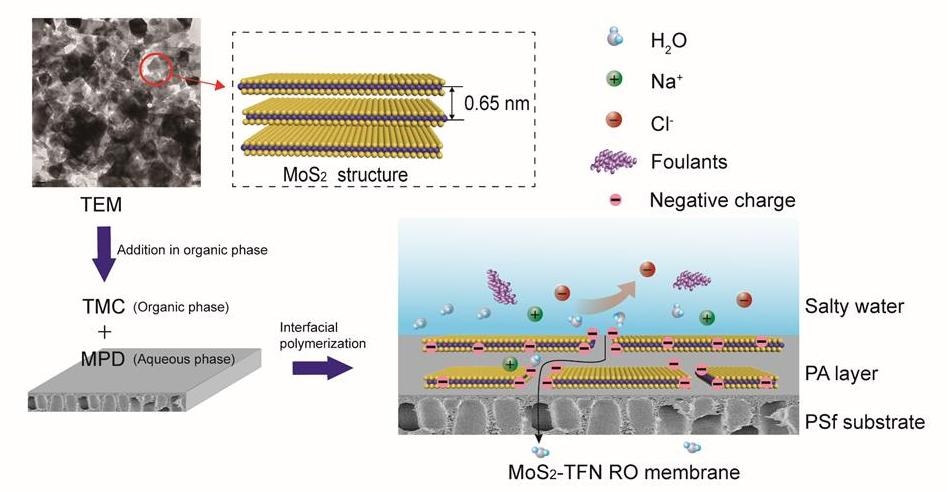Jun 7 2019
Reverse osmosis (RO) desalination technology is one of the most valuable methods for tackling the global water scarcity by generating fresh water from groundwater, sea water, and other wastewater sources.
 Scheme of MoS2-TFN membrane fabrication process and the underlying mechanism for superior desalination performance. (Image credit: ZHANG Kaisong)
Scheme of MoS2-TFN membrane fabrication process and the underlying mechanism for superior desalination performance. (Image credit: ZHANG Kaisong)
However, the conventional technique necessitates high energy consumption, and the process is limited by many issues such as restricted water flux, an inferior fouling resistance, and inadequate salt rejection. In order to decrease the cost and energy input linked with water desalination, highly perm-selective and economical antifouling RO membranes are needed.
Recently, the advance of two-dimensional (2D) nanomaterials has allowed the emergence of new approaches for fabrication and modification of thin film nanocomposite (TFN) RO membranes. It was discovered that atomically thick 2D layered materials pave a new pathway for customizing the mechanical strength, membrane structure, surface charge, charge density, surface hydrophilicity, and surface roughness in the PA skin layer.
On the basis of this, the team of scientists of Membrane Science and Technology headed by Prof. ZHANG Kaisong from the Institute of Urban Environment, Chinese Academy of Sciences, produced 2D graphene analog molybdenum disulfide (MoS2) in high-throughput via ultrasound-assisted solvent exfoliation. The exfoliated layered MoS2 nanosheets were approximately 2.2 nm thick with two to three layers and highly negatively charged properties.
A new thin-film nanocomposite (TFN) reverse osmosis (RO) membrane was successfully developed with prepared laminar MoS2 as fillers in the organic phase via interfacial polymerization of trimesoyl chloride monomers and m-phenylenediamine.
Using transmission electron microscopy (TEM), it was confirmed that the laminar nanosheets were scattered both in the PA matrix and on the membrane surface.
When compared to commercial RO membrane (BW-30) and pristine membrane, the tailored TFN membrane exhibited an improved water flux and salt rejection, and also excellent protein fouling resistance. It was primarily attributed to the enhanced membrane surface hydrophilicity.
Furthermore, the electrostatic repulsions among membrane surface, salt ions, and negatively charged foulants were improved due to the integrated highly negatively charged 2D nanosheets, resulting in an enhanced fouling resistance and salt rejection.
Researchers consider that TFN RO membranes modified with 2D nanomaterial with unique properties may signify the next generation of high-performance RO membranes in water desalination.
The research titled “Thin film nanocomposite reverse osmosis membrane modified by two dimensional laminar MoS2 with improved desalination performance and fouling-resistant characteristics” has been reported in Desalination.
This study was funded by the Key Project of International Cooperation, the Bureau of International Cooperation, the Chinese Academy of Sciences, and the Key Project of Frontier Science, CAS.